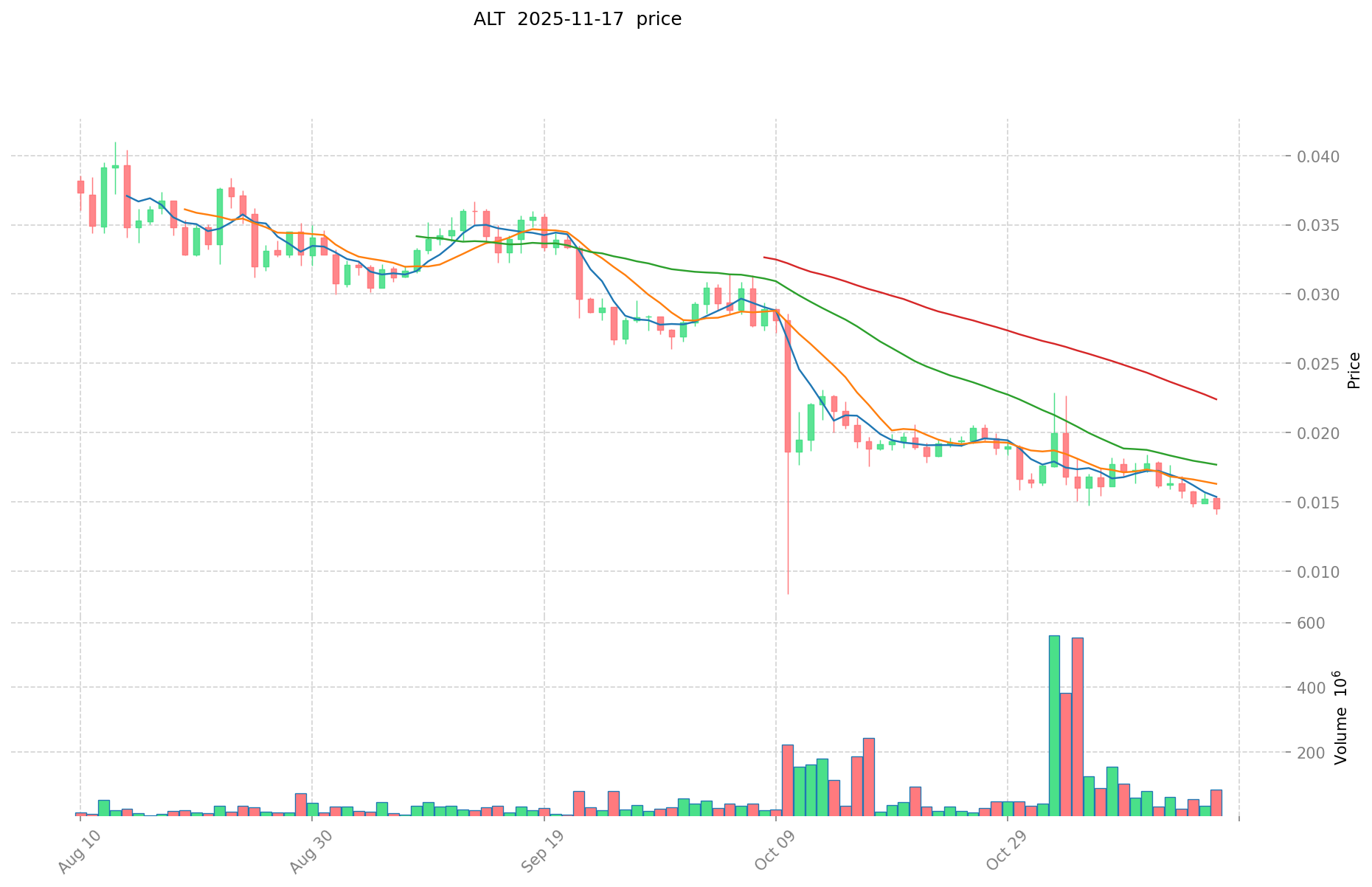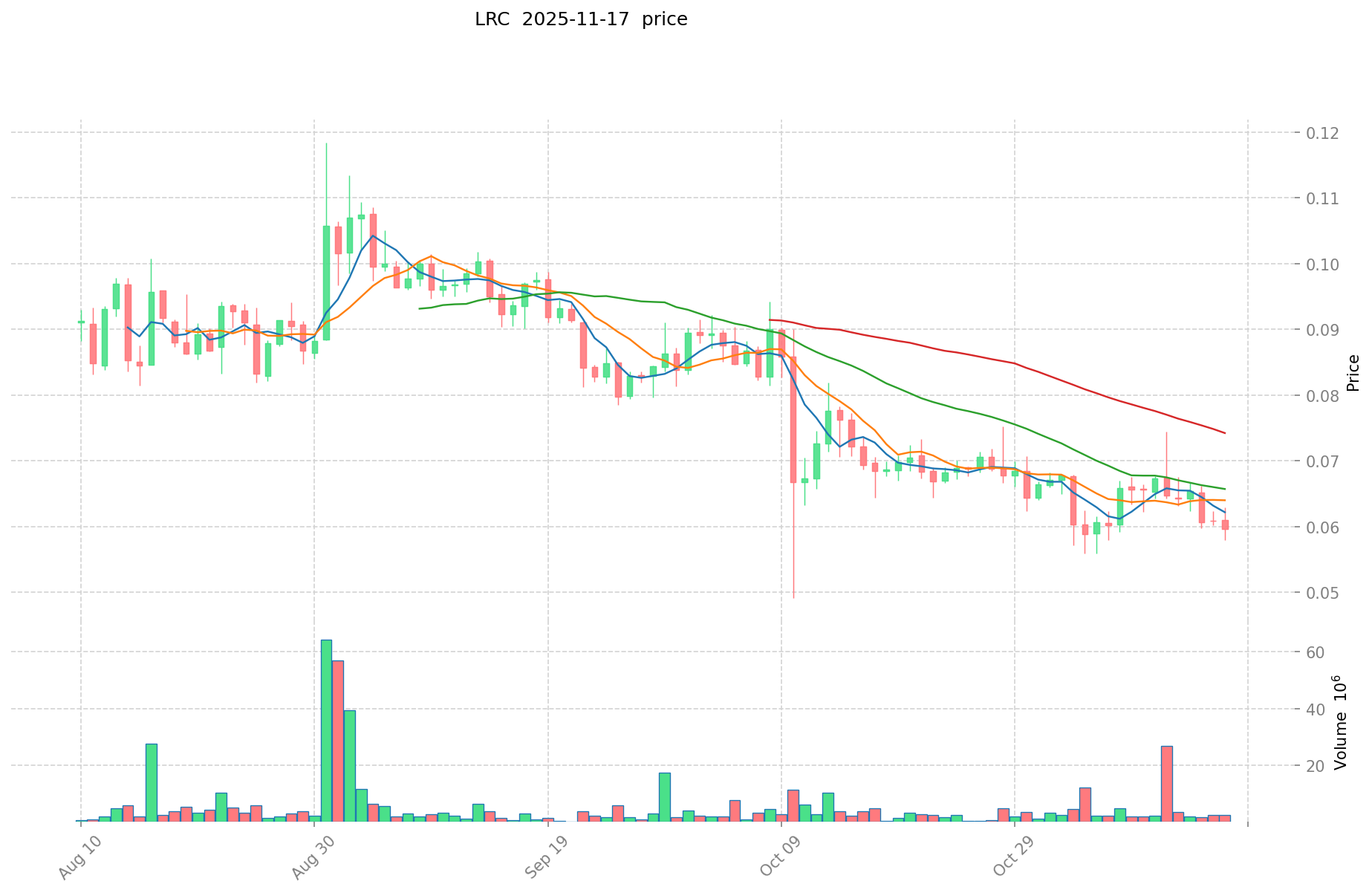ALT vs LRC: A Comparative Analysis of Audio Lyrics Formats in Digital Music
Introduction: Investment Comparison of ALT vs LRC
In the cryptocurrency market, the comparison between AltLayer vs Loopring has been an unavoidable topic for investors. The two not only show significant differences in market cap ranking, application scenarios, and price performance, but also represent different positioning in crypto assets.
AltLayer (ALT): Since its launch in 2024, it has gained market recognition for its novel approach to restaked rollups and enhanced security for blockchain networks.
Loopring (LRC): Introduced in 2017, it has been hailed as a pioneer in decentralized exchange protocols, offering zero-risk token exchange models on Ethereum.
This article will comprehensively analyze the investment value comparison between AltLayer and Loopring, focusing on historical price trends, supply mechanisms, institutional adoption, technological ecosystems, and future predictions, attempting to answer the question investors care about most:
"Which is the better buy right now?"
I. Price History Comparison and Current Market Status
ALT (Coin A) and LRC (Coin B) Historical Price Trends
- 2024: ALT reached its all-time high of $0.6948 on March 27, 2024, likely due to significant project developments or market optimism.
- 2021: LRC hit its all-time high of $3.75 on November 10, 2021, possibly influenced by the overall crypto market bull run and increased interest in Layer 2 solutions.
- Comparative Analysis: In the recent market cycle, ALT has fallen from its high of $0.6948 to a current price of $0.01463, while LRC dropped from $3.75 to $0.06027, both experiencing significant declines from their peak values.
Current Market Situation (2025-11-17)
- ALT current price: $0.01463
- LRC current price: $0.06027
- 24-hour trading volume: ALT $1,241,144.84 vs LRC $158,695.69
- Market Sentiment Index (Fear & Greed Index): 10 (Extreme Fear)
Click to view real-time prices:
- Check ALT current price Market Price
- Check LRC current price Market Price


II. Core Factors Affecting ALT vs LRC Investment Value
Supply Mechanism Comparison (Tokenomics)
- ALT: Fixed supply cap of 1 billion tokens with a deflationary model where tokens are burned through protocol activity
- LRC: Maximum supply of approximately 1.37 billion tokens with a deflationary mechanism through transaction fee burning
- 📌 Historical pattern: Deflationary token models tend to create upward price pressure during periods of increased network activity, with both protocols showing similar supply-constraining mechanisms.
Institutional Adoption and Market Applications
- Institutional holdings: LRC has gained more institutional attention through its Layer 2 zkRollup solution for Ethereum, attracting investors focused on scaling solutions
- Enterprise adoption: ALT focuses on cross-chain interoperability and modular solutions, while LRC is primarily adopted for DEX infrastructure and payment applications
- Regulatory attitudes: Both tokens operate in the regulatory gray area of most jurisdictions, though LRC's close integration with Ethereum may provide it more regulatory clarity in regions where ETH is well-defined
Technical Development and Ecosystem Building
- ALT technical upgrades: Focused on modular blockchain architecture and cross-chain interoperability
- LRC technical development: Continued enhancement of zkRollup technology for Ethereum scaling, with emphasis on reducing transaction costs and increasing throughput
- Ecosystem comparison: LRC has stronger integration with Ethereum DeFi applications, while ALT is building broader cross-chain functionality for various blockchain ecosystems
Macroeconomic and Market Cycles
- Performance in inflationary environments: Both tokens have limited historical data in varying inflation environments, but their deflationary mechanisms theoretically provide some inflation resistance
- Macroeconomic monetary policy: Both tokens show correlation with broader crypto market moves in response to interest rate changes and USD strength
- Geopolitical factors: Cross-border transaction demand benefits both tokens, with ALT potentially offering advantages through its cross-chain architecture in fragmented regulatory environments
III. 2025-2030 Price Prediction: ALT vs LRC
Short-term Prediction (2025)
- ALT: Conservative $0.0112 - $0.0146 | Optimistic $0.0146 - $0.0198
- LRC: Conservative $0.0360 - $0.0601 | Optimistic $0.0601 - $0.0787
Mid-term Prediction (2027)
- ALT may enter a growth phase, with expected price range of $0.0117 - $0.0224
- LRC may enter a bullish market, with expected price range of $0.0583 - $0.1208
- Key drivers: Institutional fund inflows, ETFs, ecosystem development
Long-term Prediction (2030)
- ALT: Base scenario $0.0170 - $0.0233 | Optimistic scenario $0.0233 - $0.0329
- LRC: Base scenario $0.0983 - $0.1277 | Optimistic scenario $0.1277 - $0.1481
Disclaimer
ALT:
| 年份 | 预测最高价 | 预测平均价格 | 预测最低价 | 涨跌幅 |
|---|---|---|---|---|
| 2025 | 0.0198424 | 0.01459 | 0.0112343 | 0 |
| 2026 | 0.02238106 | 0.0172162 | 0.016699714 | 17 |
| 2027 | 0.0223724519 | 0.01979863 | 0.0116811917 | 35 |
| 2028 | 0.0242483720925 | 0.02108554095 | 0.0137056016175 | 44 |
| 2029 | 0.024026973912525 | 0.02266695652125 | 0.016773547825725 | 54 |
| 2030 | 0.032919220955811 | 0.023346965216887 | 0.017043284608327 | 59 |
LRC:
| 年份 | 预测最高价 | 预测平均价格 | 预测最低价 | 涨跌幅 |
|---|---|---|---|---|
| 2025 | 0.0786786 | 0.06006 | 0.036036 | 0 |
| 2026 | 0.101972871 | 0.0693693 | 0.052720668 | 15 |
| 2027 | 0.120796230555 | 0.0856710855 | 0.05825633814 | 42 |
| 2028 | 0.120783379892175 | 0.1032336580275 | 0.058843185075675 | 71 |
| 2029 | 0.143370904268592 | 0.112008518959837 | 0.095207241115861 | 85 |
| 2030 | 0.148120065472489 | 0.127689711614214 | 0.098321077942945 | 111 |
IV. Investment Strategy Comparison: ALT vs LRC
Long-term vs Short-term Investment Strategy
- ALT: Suitable for investors focused on cross-chain interoperability and modular blockchain solutions
- LRC: Suitable for investors interested in Ethereum scaling solutions and DEX infrastructure
Risk Management and Asset Allocation
- Conservative investors: ALT: 30% vs LRC: 70%
- Aggressive investors: ALT: 60% vs LRC: 40%
- Hedging tools: Stablecoin allocation, options, cross-currency portfolios
V. Potential Risk Comparison
Market Risk
- ALT: Relatively new project, potentially higher volatility
- LRC: Dependency on Ethereum ecosystem performance
Technical Risk
- ALT: Scalability, network stability
- LRC: Concentrated development team, potential security vulnerabilities
Regulatory Risk
- Global regulatory policies may impact both tokens differently, with LRC potentially benefiting from closer association with Ethereum's regulatory status
VI. Conclusion: Which Is the Better Buy?
📌 Investment Value Summary:
- ALT advantages: Cross-chain interoperability, modular blockchain solutions
- LRC advantages: Established Ethereum Layer 2 solution, strong DEX infrastructure
✅ Investment Advice:
- New investors: Consider a balanced approach with a slight bias towards LRC due to its more established position
- Experienced investors: Explore ALT for its growth potential while maintaining exposure to LRC
- Institutional investors: Evaluate both for portfolio diversification, with emphasis on LRC for its Ethereum ecosystem integration
⚠️ Risk Warning: The cryptocurrency market is highly volatile. This article does not constitute investment advice. None
VII. FAQ
Q1: What are the main differences between ALT and LRC? A: ALT focuses on cross-chain interoperability and modular blockchain solutions, while LRC is primarily an Ethereum Layer 2 scaling solution for decentralized exchanges.
Q2: Which token has performed better historically? A: LRC reached a higher all-time high of $3.75 in November 2021, compared to ALT's all-time high of $0.6948 in March 2024. However, both have experienced significant declines since their peaks.
Q3: How do the supply mechanisms of ALT and LRC compare? A: Both tokens have deflationary models. ALT has a fixed supply cap of 1 billion tokens with burning through protocol activity, while LRC has a maximum supply of about 1.37 billion tokens with burning through transaction fees.
Q4: Which token is more suitable for long-term investment? A: This depends on your investment strategy. ALT may be suitable for those interested in cross-chain solutions, while LRC might appeal to investors focusing on Ethereum ecosystem development.
Q5: What are the main risks associated with investing in ALT and LRC? A: For ALT, risks include its relative newness and potential volatility. For LRC, risks are tied to its dependency on Ethereum's ecosystem performance. Both face regulatory risks common to cryptocurrencies.
Q6: How do institutional adoptions compare between ALT and LRC? A: LRC has gained more institutional attention due to its established position as an Ethereum Layer 2 solution, while ALT is still building its institutional presence in the cross-chain interoperability space.
Q7: What are the price predictions for ALT and LRC by 2030? A: By 2030, ALT is predicted to range from $0.0170 to $0.0329, while LRC is expected to range from $0.0983 to $0.1481 in optimistic scenarios. However, these predictions are speculative and subject to market conditions.
Share
Content